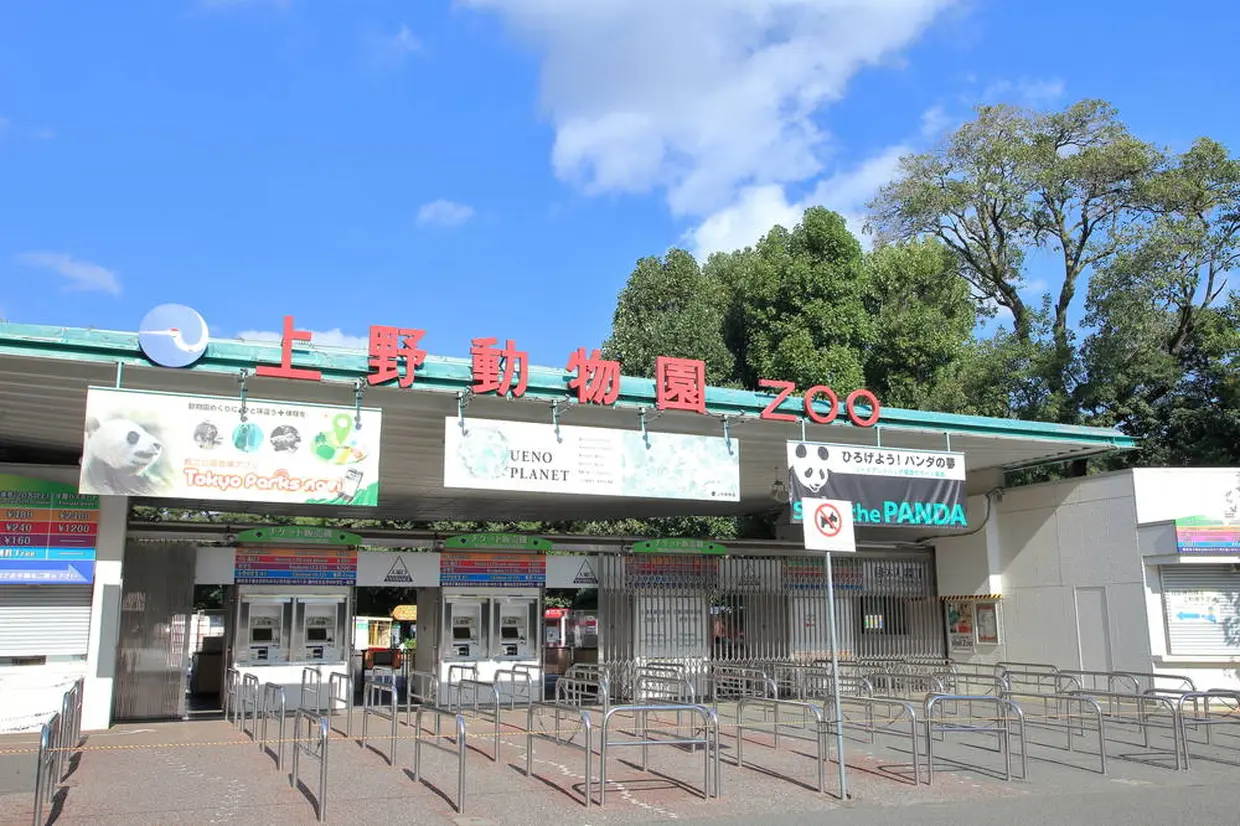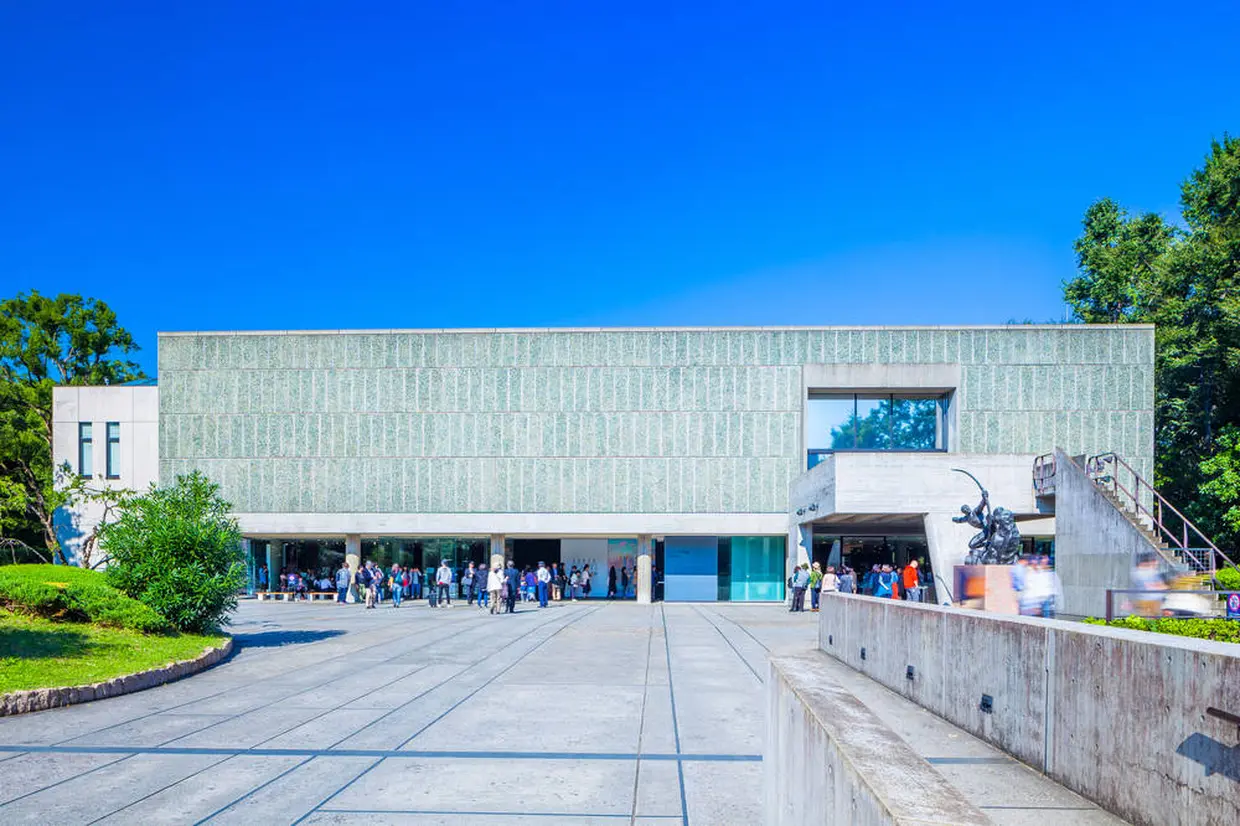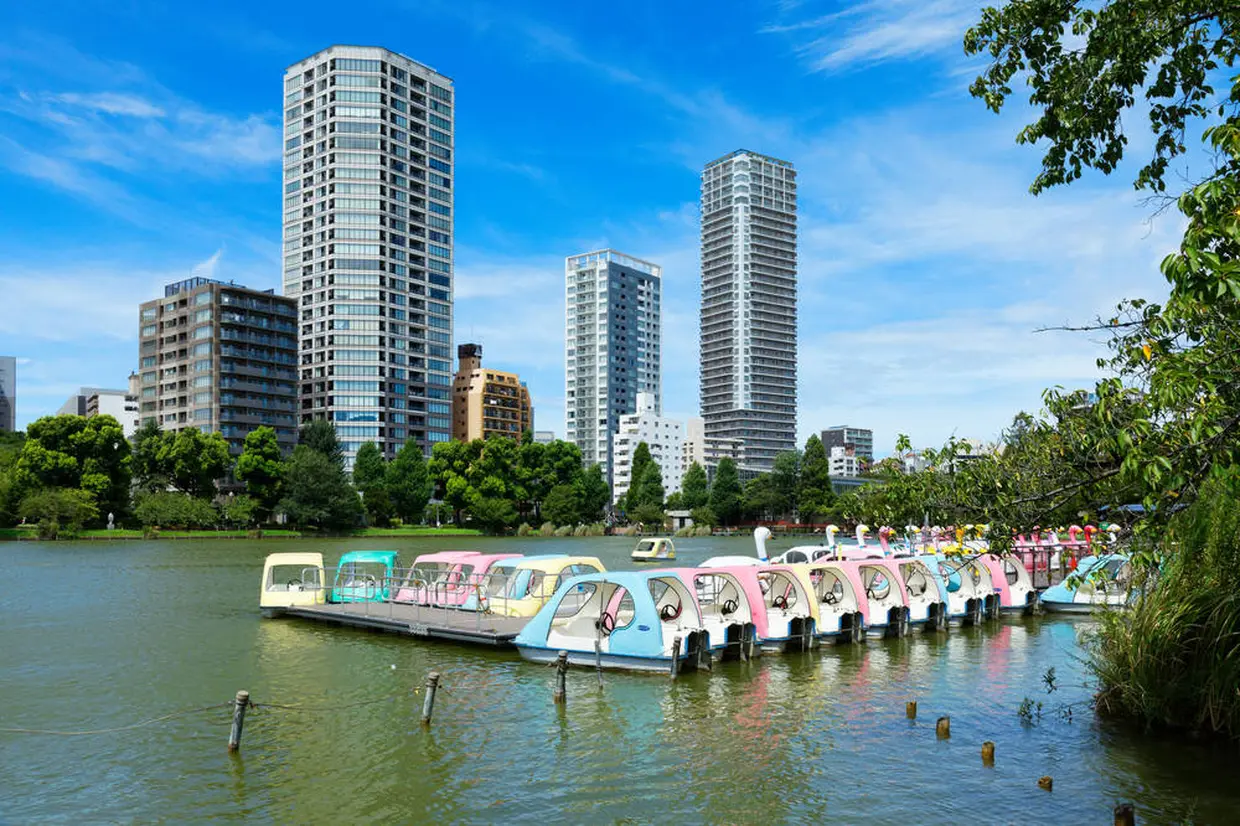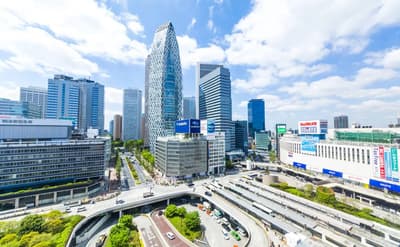What is Ueno Park?

Ueno Park is one of the most famous parks in Tokyo and a popular tourist spot with many cultural facilities, temples, and shrines. The vast grounds are rich in nature, featuring cherry blossom trees dating back to the Edo period and a pond with floating lotus flowers, making it an urban oasis.

The park has a variety of cultural facilities, including a museum, zoo, and library. In addition to these cultural attractions, you’ll find a long-established French restaurant, Ueno Seiyoken, as well as cafes, other restaurants, sports facilities, the Shinobazu Pond Boat House, and various stores. With such diverse offerings, you can easily spend a whole day here without getting bored.
Some spots in Ueno Park require a separate admission fee, but admission to the park itself is free. The park is only about a 2-minute walk from JR Line Ueno Station, making it easily accessible.
5 Things to Do in Ueno Park
Experience Japanese history and art, and interact with animals
Ueno Zoo

Ueno Zoo was the first zoo in Japan, opened in 1882, and is located on the north side of Ueno Park. 3,000 animals of about 300 different species live in the East Garden and West Garden.
Ueno Zoo has two major features. The first is the exhibition of giant pandas. Since there are only three zoos in Japan housing pandas, many visitors come to the zoo specifically to see these beloved animals.
The second feature is the presence of historical buildings inside the park. To the left of the main gate stands the Five-storied Pagoda of the Former Kan’ei-ji Temple, a National Important Cultural Property, which was rebuilt in 1639. There is also a tea ceremony house, KanKan-tei, built in the Edo period. It was once destroyed by fire, but was rebuilt in 1878.
Opening Hours: 9:30am-5:00pmClosed: Mondays (or the following day if Monday is a National Holiday or Tokyo Citizen’s Day (October 1)), year-end and New Year holidaysPrice: Adults (16-64): 600 yen, Seniors (65+): 300 yen, Students (13-15): 200 yen, Children (0-12): free Address:9-83, Ueno Park,Taito-ku, TokyoOfficial website: tokyo-zoo.net/english/ueno/index.html
Tokyo National Museum
Founded in 1872, the Tokyo National Museum is the oldest museum in Japan. The buildings are divided by 6 exhibits: Honkan for Japanese art, Heiseikan for Japanese archaeology, Toyokan for oriental art, The Gallery of Horyuji Treasures for the collection of Horyuji Treasures, Hyokeikan for special exhibitions and events, and Kuroda Memorial Hall, which exhibits the works of Kuroda Seiki, a Western-style painter, is located off-site. Almost every week, one of the galleries changes its exhibits, so visitors can make new discoveries no matter how many times they visit.
Opening Hours: 9:30 am-5:00 pm (Friday and Saturday: 9:30am-7:00pm)Closed: Mondays (or the following weekday if Monday is a national holiday), Year-end and New Year holidays *Special holidays may apply.Price:Adults: 1,000 yenUniversity Students: 500 yenHigh/Junior High/Elementary School Students and persons under 18 and over 70: Free (*Please show proof of age when entering.)Address: 13-9 Ueno Park, Taito-ku, TokyoOfficial website: tnm.jp/?lang=en
National Museum of Nature and Science

Founded in 1877, the National Museum of Nature and Science has a long history. With the motto of “Explore the Power of Imagination,” the museum houses a variety of exhibits related to natural history and the history of science and technology. The museum also serves as a core facility for science museums in Japan and other Asian countries, conducting research and providing learning support.
In addition to the permanent indoor exhibits, such as the Japan Gallery where visitors can learn about the origins of the Japanese archipelago and changes in its creatures, and the Global Gallery, where visitors can explore the history of the Earth, there are outdoor exhibits. These include the launch pad of the first artificial satellite launched in Japan in 1970 and a model of a blue whale. The museum also hosts special and temporary exhibitions.
Opening Hours: 9:00am-5:00pmClosed: Mondays (or the following weekday if Monday is a national holiday), Year-end and New Year holidays *Special holidays may apply.Price: General and university students: 630 yen, High-school students and younger: freeAddress: 7-20 Ueno Park, Taito-ku, TokyoOfficial website:linkkahaku.go.jp/english/
National Museum of Western Art

The National Museum of Western Art exhibits the collection of Kojiro Matsukata, a Japanese businessman, and Western art from the Renaissance to the early 20th century, as well as donated works, in its permanent collection. In addition to the permanent collection, the museum holds a variety of special exhibitions, making it one of Japan’s leading art museums.
Besides the exhibitions, the museum also serves as a base for a wide range of activities related to Western art, including collection, conservation and restoration, and information dissemination. There are three buildings: the Main Building, the New Wing, and the Special Exhibition Wing. The Main Building was designed by French architect, Le Corbusier, one of the most famous architects of the 20th century, and is a historical building registered as a World Cultural Heritage Site.
Opening Hours: 9:30am-5:30pm (Friday and Saturday 9:30am-8:00pm)Closed: Mondays (or the following weekday if Monday is a national holiday), Year-end and New Year holidays *Special holidays may apply.Permanent exhibition fee:Adults: 500 yenCollege students: 250 yenHigh school students or younger/Those over the age of 65/Those under the age of 18: freeAddress: 7-7 Ueno-koen, Taito-ku, TokyoOfficial website: nmwa.go.jp/en/
Tokyo Metropolitan Art Museum

The Tokyo Metropolitan Art Museum holds a variety of art exhibitions throughout the year, including major exhibitions where visitors can encounter masterpieces from Japan and around the world, as well as unique special exhibitions. In addition to art appreciation, the museum also offers art communication programs to connect people with artworks, people with people, and people with places through art.
The beautiful brick building was designed by Kunio Mayekawa, a master of Japanese modernist architecture. The harmony between the building and the natural surroundings of Ueno Park is one of the attractions of the Tokyo Metropolitan Art Museum. The museum also exhibits three-dimensional works, which can be viewed free of charge, so if you pass by the museum, stop by the entrance at least.
Opening Hours: 9:30am-5:30pmFriday during special exhibitions: 9:30am-8:00pmClosed: 1st and 3rd Mondays (or the following day if the day falls on a national holiday or substitute holiday), year-end and New Year holidays, and maintenance holidaysSpecial and temporary exhibitions: Closed on Mondays (or the following day if the Monday is a national holiday or substitute holiday)Price: Entrance fee is free while there is a varying admission fee for each exhibition.Address: 8-36 Ueno-Park Taito-ku, TokyoOfficial Website :https://www.tobikan.jp/en/index.html
Historical spots tour
Toezan Kann’ei-ji Kompon Chu-do
Kann’ei-ji Kompon Chu-do is the central building of Kann’ei-ji, a temple built in the Edo period to pray for the safety of the Tokugawa Shogunate and the well-being of the citizens.
In fact, the entire Ueno Park was originally the grounds of Kann’ei-ji, and the historic buildings located throughout the park are remains of Kann’ei-ji buildings or those that were initially owned by Kann’ei-ji.
Kann’ei-ji Kompon Chu-do is the cemetery for six successive shoguns of the Edo period and continues to protect the mausoleum of the Tokugawa shoguns.
Address: 1-14-11 Ueno Sakuragi, Taito-ku, TokyoOfficial website: kaneiji.jp/pdf/english.pdf
Kiyomizu Kannon-do

Kiyomizu Kannon-do, which is the same building as Kann’ei-ji Kompon Chu-do introduced above, is a stage building resembling the Kiyomizu-dera Temple in Kyoto. It has been a popular spot for the people since the Edo period, and is still crowded with tourists today.
The Matsu of the Moon, with its thick, rounded branches in front of the hall, is particularly famous, and was painted by ukiyo-e artist Hiroshige Utagawa in the Edo period as one of his “Meisho Edo Hyakkei”. Looking at the Matsu of the Moon from the stage, the Benten-do Temple on the banks of Shinobazu Pond can be seen in the center of the rounded branches. If you go down the stairs and look back, you can see Kiyomizu Kannon-do in the background of the Matsu of the Moon. You can enjoy the view from various angles.
Address: 1-29 Ueno Park, Taito-ku, TokyoOfficial website: kiyomizu.kaneiji.jp/pdf/english.pdf
Former Kan’ei-ji Temple Five-storied Pagoda

Former Kan’ei-ji Temple Five-storied Pagoda is a building designated as a National Important Cultural Property. The five-storied structure, which rises 36 meters from the ground to the top of the pagoda, is one of the symbolic buildings of Ueno.
Originally owned by Kan’ei-ji, the building is now managed by the Tokyo Metropolitan Government and stands quietly within the Ueno Zoo. It can be seen from outside the zoo, but those who wish to see it up close must enter the zoo.
Address: 9-88 Ueno Park, Taito-ku, Tokyo (in Uno Park)
Ueno Toshogu Shrine

Surrounded by the Ueno Zoo grounds, Ueno Toshogu Shrine is one of many shrines in Japan dedicated to Lord Tokugawa Ieyasu, the founder of the Edo shogunate. The shrine is said to bring good luck, victory, success in life, and health and longevity.
The shrine building, built by Lord Iemitsu, the third shogun of the Edo Shogunate, features a main hall richly decorated with gold foils, making it an eye-catching and luxurious structure. Eventually, it earned the nickname the ‘shrine of gold.’ Enduring many hardships, including wars, earthquakes, and air raids, the building is designated as an important cultural property of Japan.
One of the highlights of Ueno Toshogu Shrine is its seasonal scenery. The cherry blossoms in spring and the autumn leaves in fall are beautiful and attract many visitors. In addition, there is a Peony Garden in a corner of the grounds, where visitors can walk slowly through the Japanese garden and admire the colorful and gorgeous peony blossoms during the peony season from January to February.
Address: 9-88 Ueno Park, Taito-ku, TokyoOfficial website:linkuenotoshogu.com/en/
Feel the history through the statues
Saigo Takamori Statue

The Saigo Takamori Statue in Ueno Park is a symbol of Ueno Park for more than 100 years. He is one of the historical figures who contributed to the overthrow of the Tokugawa Shogunate, which lasted about 260 years, and the establishment of the Meiji government. He was beloved by many people.
There are three Saigo Takamori Statues in Japan, but this one in Ueno is based on the motif of Saigo, a dog lover, going out with his dog, Tsun, giving off Saigo’s gentle atmosphere. This 3.7-meter tall statue was designed to look well-balanced when viewed from the feet up.
Ueno Daibutsu

The Ueno Daibutsu, located near the rows of cherry trees in Ueno Park, was once a 6 meter tall statue. However, due to several earthquakes and wars, it has now become about the height of a person.
Since the Daibutsu has lost its torso and other parts and only the face is enshrined as a relief, it has become a popular sacred site for students preparing for entrance exams, who believe that the Daibutsu will not fall any further. It is rare to see the face of Daibutsu up close, so stop by when strolling in the park.
Hideyo Noguchi Statue

Hideyo Noguchi, a bacteriologist famous for his research on yellow fever whose face appears on Japanese banknotes, stands on the east side of the Grand Fountain in Ueno Park, dressed in lab coat and holding a test tube in his right hand.
Surrounded by ginkgo trees, it is a great photo spot in the fall. With the yellowing ginkgo trees in the background, and during the time when the leaves are falling, the Hideyo Noguchi Statue can be photographed along with the beautiful scenery as if it were covered with a yellow carpet.
Feel the nature unfolding throughout the changing seasons

Ueno Park is a popular spot where you can see many seasonal plants and feel close to nature despite being in the city. Visitors can spend a relaxing time strolling through the park and enjoying the scenery of blooming flowers and changing leaves.
The park is especially famous for its cherry blossoms, which have been a popular attraction since the Edo period. In the park, the early cherry blossoms begin to bloom in March, and can be enjoyed for a long period of time until the Yoshino cherry blossoms bloom in April.
In Japan, there is a custom of cherry blossom viewing (Hanami) where people drink sake and eat a box lunch (Bento) under the cherry blossoms. Here in Ueno Park, the rows of cherry trees are famous as a hanami spot!

The lotus flowers at Shinobazu Pond are at their best around the end of July each year. The breathtaking sight of pink lotus flowers peeking out from among the large green leaves all at once is truly beautiful. This natural display, combined with the presence of the Benten-do Temple standing in the center of the pond, creates a fantastic photo opportunity.

The large park is planted with many trees that turn red in the fall, including ginkgo, zelkova, maple and so on. The best time to view the leaves is usually from mid-November to early December.
The area around the Grand Fountain is a recommended spot for fall foliage. You can enjoy the beautiful view of the trees on either side of the fountain as they change colors. The area around Ueno Daibutsu is also a good place to enjoy the red color of the Japanese maple trees, and the yellow color of the ginkgo tree next to the Five-storied Pagoda can be seen from the approach to Ueno Toshogu Shrine.
Take a boat ride and enjoy the scenery

Shinobazu Pond is a large pond located on the west side of Ueno Park. In the center is a historic building called Shinobazu Benten-do. Migratory birds, ducks, and other waterfowl are abundant in the pond. In summer, the lotus pond is covered with lotus leaves several meters high and peach-colored flowers can be seen.
The Boat Pond is one of the most popular spots at the spacious Shinobazu Pond. A rowboat that can accommodate up to three adults can be rented for 500 yen for 30 minutes, a cycle boat that can accommodate up to two adults and one child for 700 yen for 30 minutes, and a swan boat that can accommodate up to two adults and two children for 800 yen for 30 minutes. The view of the park from the pond has a different attraction, so if you have time, experience it for yourself.
Opening Hours: Varies depending on the season *Subject to change depending on time of year and conditionsClosed: Wednesdays from December to FebruaryOfficial Website :https://www.tokyo-park.or.jp/park/format/facilities038.html#tkp-secton-02
Enjoy the food at Ueno Seiyoken

Ueno Seiyoken is a long-established French restaurant founded in 1872 at the beginning of the Meiji era. At that time, few people in Japan ate beef and were unfamiliar with Western cuisine. Seiyoken was a pioneer of French restaurants in Japan, and it became a glamorous social gathering place for royalty, aristocrats, and other prominent figures.
Currently, Seiyoken has branches in Ueno, Asakusa, and the Ginza area. In Ueno Park, there is the main store near Shinobazu Pond, as well as cafes and restaurants in Tokyo Bunka Kaikan, Tokyo Metropolitan Art Museum and National Science Museum.
The Ueno Seiyoken Main Store, located on the banks of Shinobazu Pond, currently houses two types of restaurants: Grill Fukushima, which serves authentic French cuisine, and a casual Western-style restaurant.
Ueno Seiyoken Grill Fukushima
Located in the main store, Grill Fukushima is Ueno Seiyoken’s main dining room, serving authentic French course meals. While maintaining tradition, the restaurant offers dishes that incorporate ideas to bring out the best of seasonal ingredients. The course menu changes monthly as the restaurant places importance on a sense of seasonality. Private rooms are also available for celebrations and dinner parties.
Opening Hours:Weekdays: 11:00am-3:00pm (Last Order 2:00pm) / 5:00pm-9:00pm (Last Order 8:00pm)Saturdays, Sundays, and holidays: 11:00 am-4:00pm (Last Order 3:00 pm) / 5:00 pm-9:00pm (Last Order 8:00pm)*All dinners are by reservation only.Closed: MondayAddress: 4-58 Ueno Park, Taito-ku, TokyoOfficial website: seiyoken.co.jp/global/en/index.html
Ueno Seiyoken Restaurant
The Restaurant offers a casual Western-style menu with terrace seating overlooking Ueno Park, where you can enjoy a view of the park’s seasonal scenery. The restaurant also offers a wide variety of dishes such as “panda plates” named after Ueno Zoo, seasonal desserts, and more.
Opening Hours:Weekdays: 11:00am-5:00pm (Last Order 4:00pm)Saturdays, Sundays and holidays: 11:00am-6:00pm (Last Order 5:00pm)Closed: MondayAddress: 4-58 Ueno Park, Taito-ku, TokyoOfficial website: seiyoken.co.jp/global/en/index.html
Cafe Art
Cafe Art in the Tokyo Metropolitan Art Museum is one of the three Ueno Seiyoken affiliated stores. With large windows allowing light to stream in and Scandinavian chairs, the interior of the cafe has an artistic atmosphere, serving light meals such as pasta and beef curry, as well as desserts and drinks.
Among them, the dessert menu in collaboration with the exhibition and the limited-edition parfait available only here are not to be missed. The cafe can be used not only during art viewing, but also as a stopover for a break from strolling around the park.
Opening Hours: 9:30am-5:30pm (Last Order 5:00pm)Closed: According to the museum’s closing daysAddress: 8-36 Ueno Park, Taito-ku, Tokyo, Inside the Tokyo Metropolitan Art Museum, 1st floorOfficial Website :https://www.seiyoken.co.jp/restaurant/tobikan/art.html
Basic Information
Ueno Park
Opening Hours: 5:00 am-11:00 pm (opening hours vary depending on the facilities)Address: 3-chome Ueno Park, Ikenohata, Taito-ku, TokyoOfficial Website :https://www.kensetsu.metro.tokyo.lg.jp/jimusho/toubuk/ueno/en_index.html
Access Information
By train
- JR Yamanote Line/Keihin-Tohoku Line/Takasaki Line/Utsunomiya Line “Ueno Station”: about 2 mins on foot
- Tokyo Metro Ginza Line/Hibiya Line “Ueno Station”: about 2 mins on foot
- Keihin Main Line “Keihin Ueno Station”: about 1 min on foot
Frequently Asked Questions
Pets are allowed to walk with their owners. However, the leash must be long enough for the owner to control the pet at hand and must be worn. And be sure to take feces home with you.
Although there are smoking areas in various locations, please smoke with good manners, for example, do not smoke in areas where many people gather or in other places where there is a risk of passive smoking.
There are lockers in Ueno Park, but they are few in number; there are several lockers in the Ueno Station premises, so it is safer to use the lockers at the station. Lockers are also available at the facilities in the park (zoo and museum).


